Cookie Policy: This site uses cookies to improve your experience. You can find out more about our use of cookies in our Privacy Policy. By continuing to browse this site you agree to our use of cookies.
SynKinase
GSK-F1
As low as
CHF 0.00
In stock
Only %1 left
SYN-1220-M0011 mgCHF 170.00
SYN-1220-M0055 mgCHF 355.00
SYN-1220-M01010 mgCHF 553.00
SYN-1220-M100100 mgINQ
SYN-1220-M05050 mgINQ

| Product Details | |
|---|---|
| Synonyms | 5-(2-Amino-4-oxo-3-(2-(trifluoromethyl)phenyl)-3,4-dihydroquinazolin-6-yl)-N-(2,4-difluorophenyl)-2-methoxypyridine-3-sulfonamide; GSKF1 |
| Product Type | Chemical |
| Properties | |
| Formula | C27H18F5N5O4S |
| MW | 603.5 |
| CAS | 1402345-92-9 |
| Purity Chemicals | ≥95% |
| Appearance | Solid. |
| Solubility | Soluble in DMSO. |
| Declaration | Manufactured by SynKinase. |
| Other Product Data |
Target: PI4KA | Kinase Group: PIKK | Substrate: Serine-Threonine Click here for Original Manufacturer Product Datasheet Our product description may differ slightly from the original manufacturers product datasheet. |
| InChi Key | MSRFVAYVUUHQCN-UHFFFAOYSA-N |
| Shipping and Handling | |
| Shipping | AMBIENT |
| Short Term Storage | +4°C |
| Long Term Storage | -20°C |
| Use/Stability | Stable for at least 2 years after receipt when stored at -20°C. |
| Documents | |
| MSDS |
 Download PDF Download PDF |
| Product Specification Sheet | |
| Datasheet |
 Download PDF Download PDF |
Description
GSK-F1 is a potent PI4KA inhibitor. It has better pharmacokinetic properties in vivo than to GSK-A1 (SYN-1219). GSK-F1 does not cross the blood-brain barrier. Phosphatidylinositol 4-kinase type IIIα (PI4KA) is a host factor essential for hepatitis C virus replication and hence is a target for drug development. RNAi studies have shown that PI4KA is a mandatory host factor in HCV replication. Down-regulation of PI4KA appears to be reasonably tolerated by cultured cell models and results.
Product References
- Pharmacological and genetic targeting of the PI4KA enzyme reveals its important role in maintaining plasma membrane phosphatidylinositol 4-phosphate and phosphatidylinositol 4,5-bisphosphate levels: N. Bojjireddy, et al.; J. Biol. Chem. 289, 6120 (2014)






